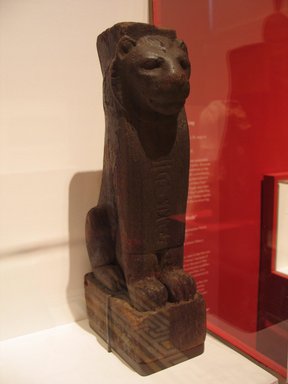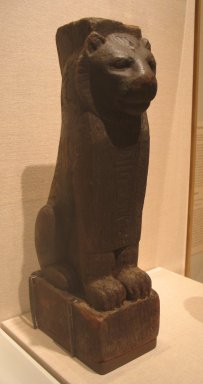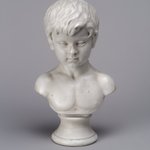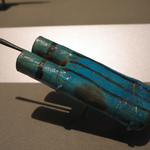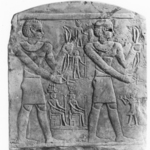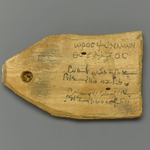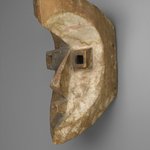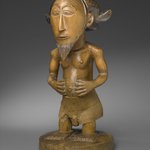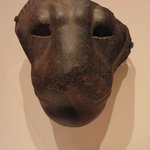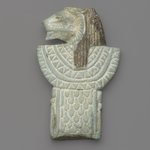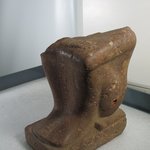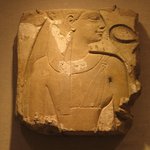

Nubian. Lion-Shaped Furniture Leg, ca. 690–664 B.C.E. Wood (Sycamore Fig, Ficus sycomorus), 13 7/8 x 3 9/16 x 5 1/2 in. (35.3 x 9 x 14 cm). Brooklyn Museum, Charles Edwin Wilbour Fund, 37.42E. Creative Commons-BY (Photo: Brooklyn Museum, 37.42E_SL1.jpg)

Nubian. Lion-Shaped Furniture Leg, ca. 690–664 B.C.E. Wood (Sycamore Fig, Ficus sycomorus), 13 7/8 x 3 9/16 x 5 1/2 in. (35.3 x 9 x 14 cm). Brooklyn Museum, Charles Edwin Wilbour Fund, 37.42E. Creative Commons-BY (Photo: Brooklyn Museum, 37.42E_NegI_SL4.jpg)

Nubian. Lion-Shaped Furniture Leg, ca. 690–664 B.C.E. Wood (Sycamore Fig, Ficus sycomorus), 13 7/8 x 3 9/16 x 5 1/2 in. (35.3 x 9 x 14 cm). Brooklyn Museum, Charles Edwin Wilbour Fund, 37.42E. Creative Commons-BY (Photo: Brooklyn Museum, CUR.37.42E_view1_wwg8.jpg)

Nubian. Lion-Shaped Furniture Leg, ca. 690–664 B.C.E. Wood (Sycamore Fig, Ficus sycomorus), 13 7/8 x 3 9/16 x 5 1/2 in. (35.3 x 9 x 14 cm). Brooklyn Museum, Charles Edwin Wilbour Fund, 37.42E. Creative Commons-BY (Photo: Brooklyn Museum, CUR.37.42E_NegI_bw.jpg)

Nubian. Lion-Shaped Furniture Leg, ca. 690–664 B.C.E. Wood (Sycamore Fig, Ficus sycomorus), 13 7/8 x 3 9/16 x 5 1/2 in. (35.3 x 9 x 14 cm). Brooklyn Museum, Charles Edwin Wilbour Fund, 37.42E. Creative Commons-BY (Photo: Brooklyn Museum, CUR.37.42E_NegJ_bw.jpg)

Nubian. Lion-Shaped Furniture Leg, ca. 690–664 B.C.E. Wood (Sycamore Fig, Ficus sycomorus), 13 7/8 x 3 9/16 x 5 1/2 in. (35.3 x 9 x 14 cm). Brooklyn Museum, Charles Edwin Wilbour Fund, 37.42E. Creative Commons-BY (Photo: Brooklyn Museum, CUR.37.42E_NegE_bw.jpg)

Nubian. Lion-Shaped Furniture Leg, ca. 690–664 B.C.E. Wood (Sycamore Fig, Ficus sycomorus), 13 7/8 x 3 9/16 x 5 1/2 in. (35.3 x 9 x 14 cm). Brooklyn Museum, Charles Edwin Wilbour Fund, 37.42E. Creative Commons-BY (Photo: Brooklyn Museum, CUR.37.42E_NegC_bw.jpg)

Nubian. Lion-Shaped Furniture Leg, ca. 690–664 B.C.E. Wood (Sycamore Fig, Ficus sycomorus), 13 7/8 x 3 9/16 x 5 1/2 in. (35.3 x 9 x 14 cm). Brooklyn Museum, Charles Edwin Wilbour Fund, 37.42E. Creative Commons-BY (Photo: Brooklyn Museum, CUR.37.42E_NegH_bw.jpg)

Nubian. Lion-Shaped Furniture Leg, ca. 690–664 B.C.E. Wood (Sycamore Fig, Ficus sycomorus), 13 7/8 x 3 9/16 x 5 1/2 in. (35.3 x 9 x 14 cm). Brooklyn Museum, Charles Edwin Wilbour Fund, 37.42E. Creative Commons-BY (Photo: Brooklyn Museum, CUR.37.42E_NegF_bw.jpg)

Nubian. Lion-Shaped Furniture Leg, ca. 690–664 B.C.E. Wood (Sycamore Fig, Ficus sycomorus), 13 7/8 x 3 9/16 x 5 1/2 in. (35.3 x 9 x 14 cm). Brooklyn Museum, Charles Edwin Wilbour Fund, 37.42E. Creative Commons-BY (Photo: Brooklyn Museum, CUR.37.42E_NegG_bw.jpg)
Lion-Shaped Furniture Leg
Egyptian, Classical, Ancient Near Eastern Art
- Reportedly from: Egypt
- Possible place made: Sudan (ancient Nubia)

